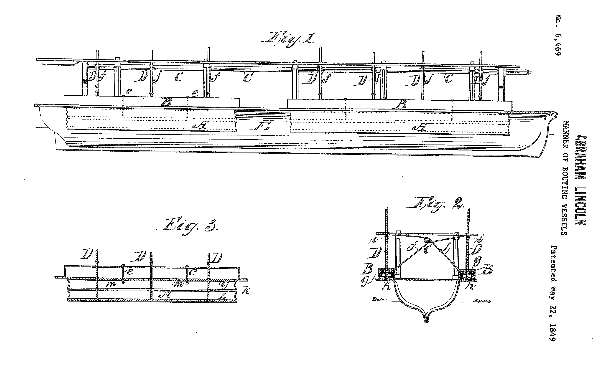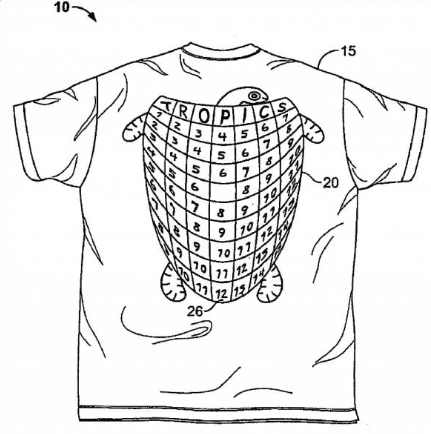Famous People and Their Curious Patents

History offers a wealth of interesting innovations, including inventions by famous individuals who will astound you with the depth and breadth of their creativity. And those innovations have resulted in some very curious patents. Most surprising is that many of these inventions have little to do with the primary occupations of their progenitors, although certainly not in all the examples that follow. The USPTO has granted many curious patents.
Abraham Lincoln was awarded a patent for his method for “buoying (lifting) vessels over shoals.” Lincoln himself was a patent lawyer, and also had a lifelong fascination for all things mechanical. He learned river navigation early by captaining a flatboat down the Ohio and Mississippi Rivers. Lincoln was a restless tinkerer. In 1848, while making his way home to Illinois, the boat on which he was traveling became stranded on a sandbar. After watching the crew work long hours to force a quantity of loose planks, barrels and boxes under the ship to free it, Lincoln considered alternative methods to more effectively overcome the cumbersome process. The patent, filed in 1847 and awarded in 1849, was never actually manufactured, but made Lincoln the only U.S. President to hold one. Unfortunately, President Lincoln’s innovation was such that the extra weight his design added to the boat actually ensured that it would get stuck.

It is interesting to consider how the mind of some of our most creative personalities actually must have functioned in generating some of the following curious patents. In some, one can readily see a direct correlation to the filer’s line of work. In others, one must understand hobbies and other interests as the curious patents have seemingly no direct application. Let’s look at a few examples of what made celebrity inventors tick:
- Michael Jackson holds a co-inventor patent with two of his costume designers for specially designed shoes that gave the illusion that he was leaning beyond his center of gravity. The shoes were created along with the famous moonwalk dance move (which is not patented) for his 1988 music video, Smooth Criminal. Here’s an example of an inventor who walked the talk.
- Next in curious patents, Steve McQueen holds a patent for a bucket seat shell. Although an actor by primary trade, most know Steve McQueen’s penchant for race car driving, hence the direct connection to car seating. Seems he did quite a lot of his best thinking about and while on his backside.
- Lawrence Welk designed and received a patent for an ornamental ash tray. What talk show host in the heydays of smoking didn’t have one of these on every desk? It isn’t hard to imagine Lawrence staring into one of these reflectively from one show to the next. Lawrence Welk even recorded a song dedicated to “smoke, smoke, smoke that cigarette”.
- Francis Ford Coppola owns a patent designed to help people get their back scratched. In keeping with curious patents, Coppola offered comedic commentary on the basis for his invention in his patent filing, the scratching turtle t shirt:
“Scratching an itch is a very common task in everyday life. It can be especially difficult, however, for a person to scratch his or her own itch when the location of the itch is in a hard-to-reach spot such as the back. Presently, absent a device such as a scratching stick, a person with an itch in a hard-to-reach location must ask a second party to scratch the itch. This, in turn, requires orienting the second-party-scratcher by using a series of directions, which are often being misunderstood by the second party. For example, these instructions might include “Could you scratch lower? To the left…No, the other left. Now, down lower. To the right. No, no…Too far! Back to the left.” This situation may arise for people in normal health and dexterity or for people with limited flexibility, such as those having spinal injuries that prevent them from bending or twisting to any significant degree. Thus, there is a need for an object that assists a person in precisely identifying a location on the person’s own body for a second party.”
How does one go from filmmaking to backscratching?

Garment for identifying location on body of the garment wearer
- In 1967, Zeppo Marx filed his application for a “Cardiac Pulse-Rate Monitor”, a unit designed to provide an audible and vibratory warning for those experiencing cardiac impairment or extreme variations in the pulse rate. One might certainly speculate about Zeppo’s rationale for developing such an application – did he cause one too many fans to laugh themselves to death?
- If you were a fan of the TV series M*A*S*H, then you will remember fondly Gary Burghoff, the actor who portrayed Radar O’Reilly. In 1992, Burghoff filed his application for an “Enhanced Fish Attractor Device,” an apparatus designed to entice fish. An avid fisherman, Radar must have had a fair amount of free time between sets, or finally acquiesced to Frank Burns’ constant retorts to “go fish.”
- Finally, there is the case of one of the most prolific inventors of our time, a name you’ve likely never heard; Yoshiro Nakamatsu, who holds many curious patents. Over the course of his lifetime, Sir Dr. NakaMats as he prefers to be called, is the holder of over 4,000 patents. He is the father of the floppy disk, conceived in 1950 at the University of Tokyo, for which he received a Japanese patent in 1952. Of course, this is disputed by IBM who claims rights to the invention that go back to 1969. To resolve the dispute, IBM put a series of licensing agreements in place with him in 1979. Among his other claims are; the CD, the DVD, the fax machine, the taxi meter, the digital watch, the karaoke machine, CinemaScope, and a host of other oddities, including an automated version of the popular Japanese game, Pachinko. At 88 years old, he sits at his desk in a central Tokyo high-rise of his own design, with a front gate appropriately shaped like a colossal floppy disk. All of this just goes to prove that creativity has no bounds.
There is a tremendous universe of diversity in the inventor community, as evidenced by some very curious patents. There are also very strong principles surrounding intellectual property rights established by governments around the world, including those of the U.S. Patent Office. It is appropriate to express a deep admiration and appreciation to those Presidents founding and fighting for a strong Intellectual Property system, including George Washington, Thomas Jefferson, James Madison, and Andrew Jackson. Their work and the work of so many others spawned an unbelievable creativity bonanza here and abroad.
The LexisNexis TotalPatent One® patent search platform enables users to create top-quality patent searches quickly and effectively.
Review recent TotalPatent One enhancements here and learn about the new search experience here.

Have Confidence in Your Results
The Patent Search Software Tool that Provides Comprehensive Results You Can Rely On.
